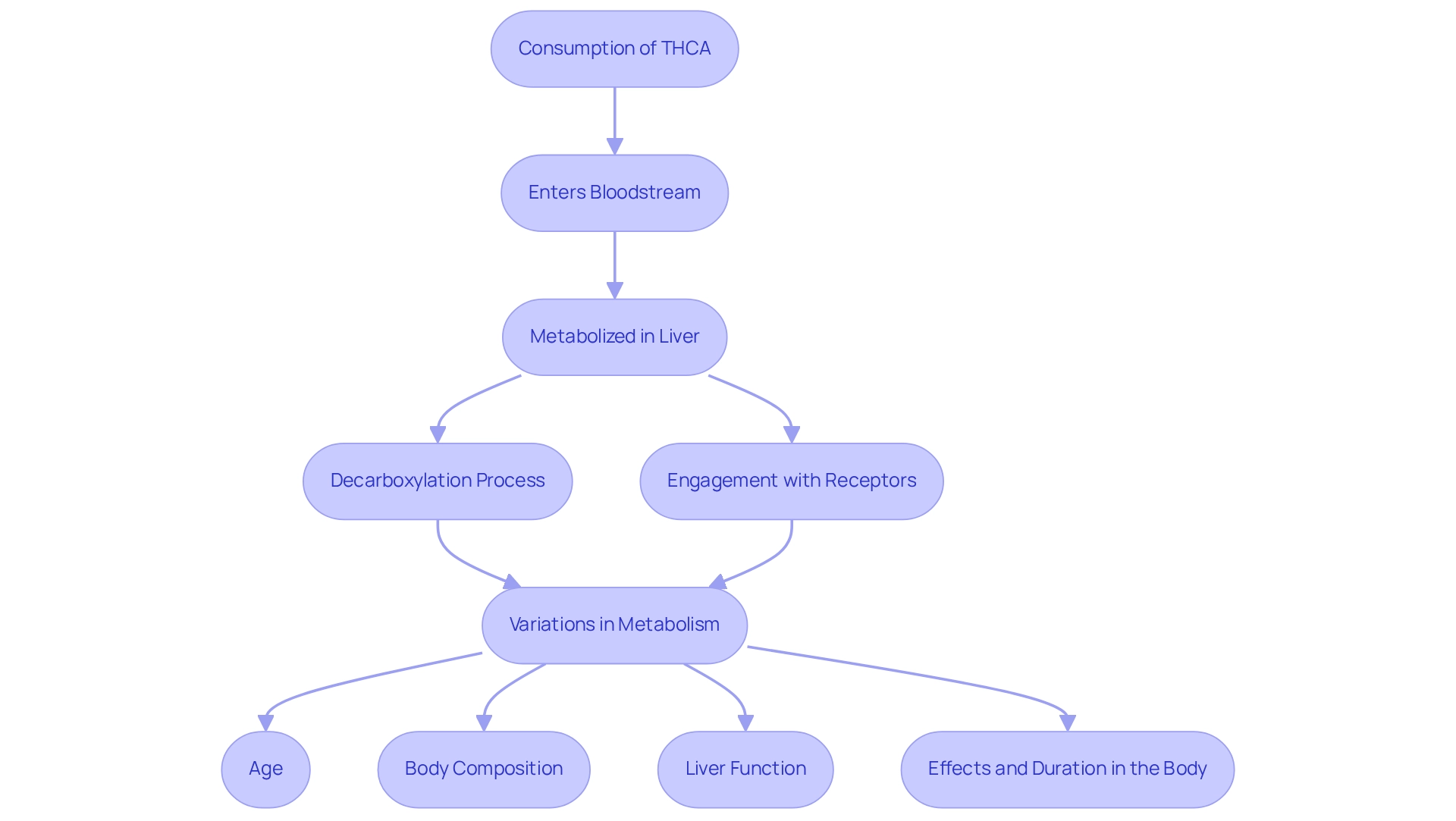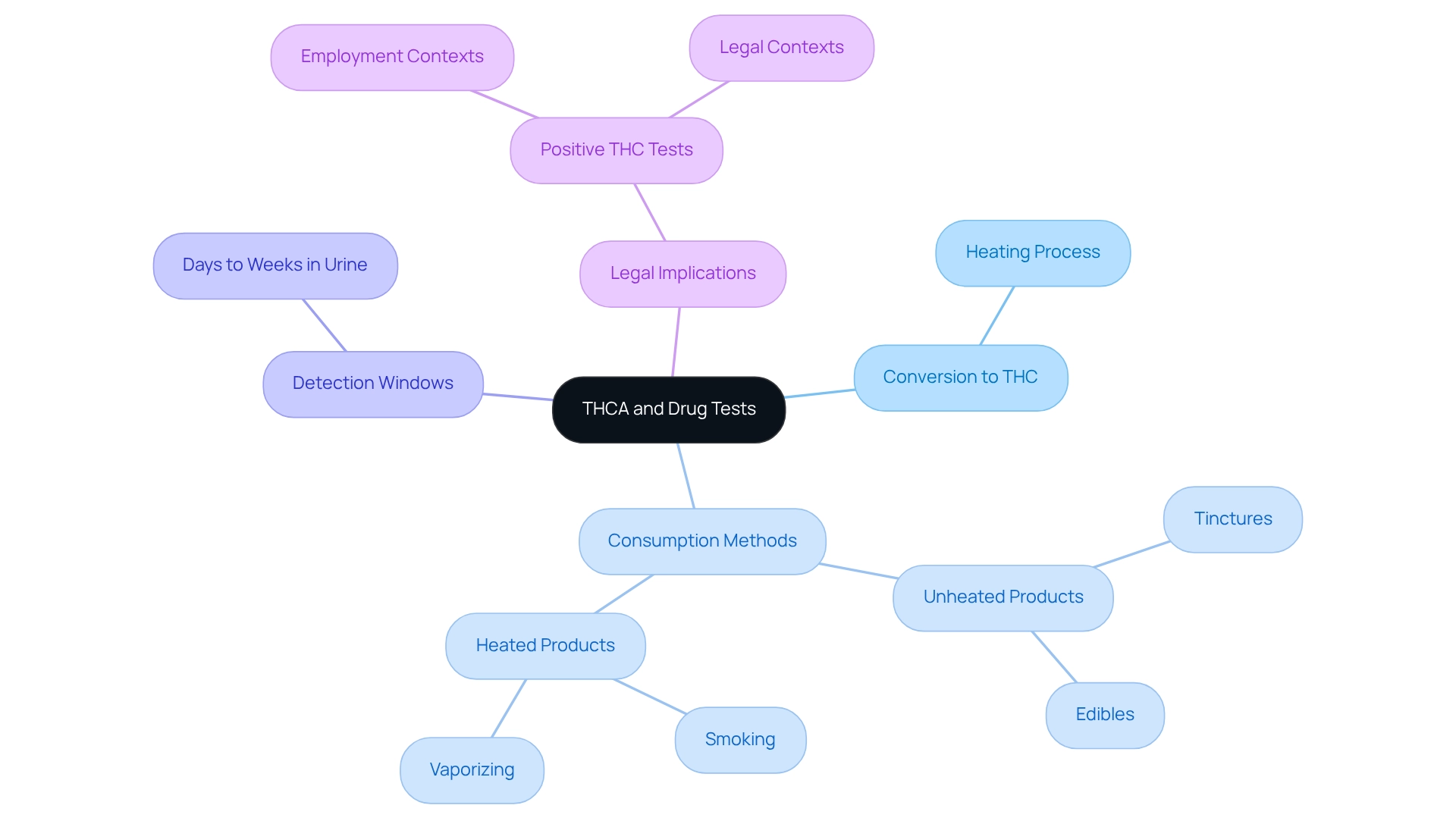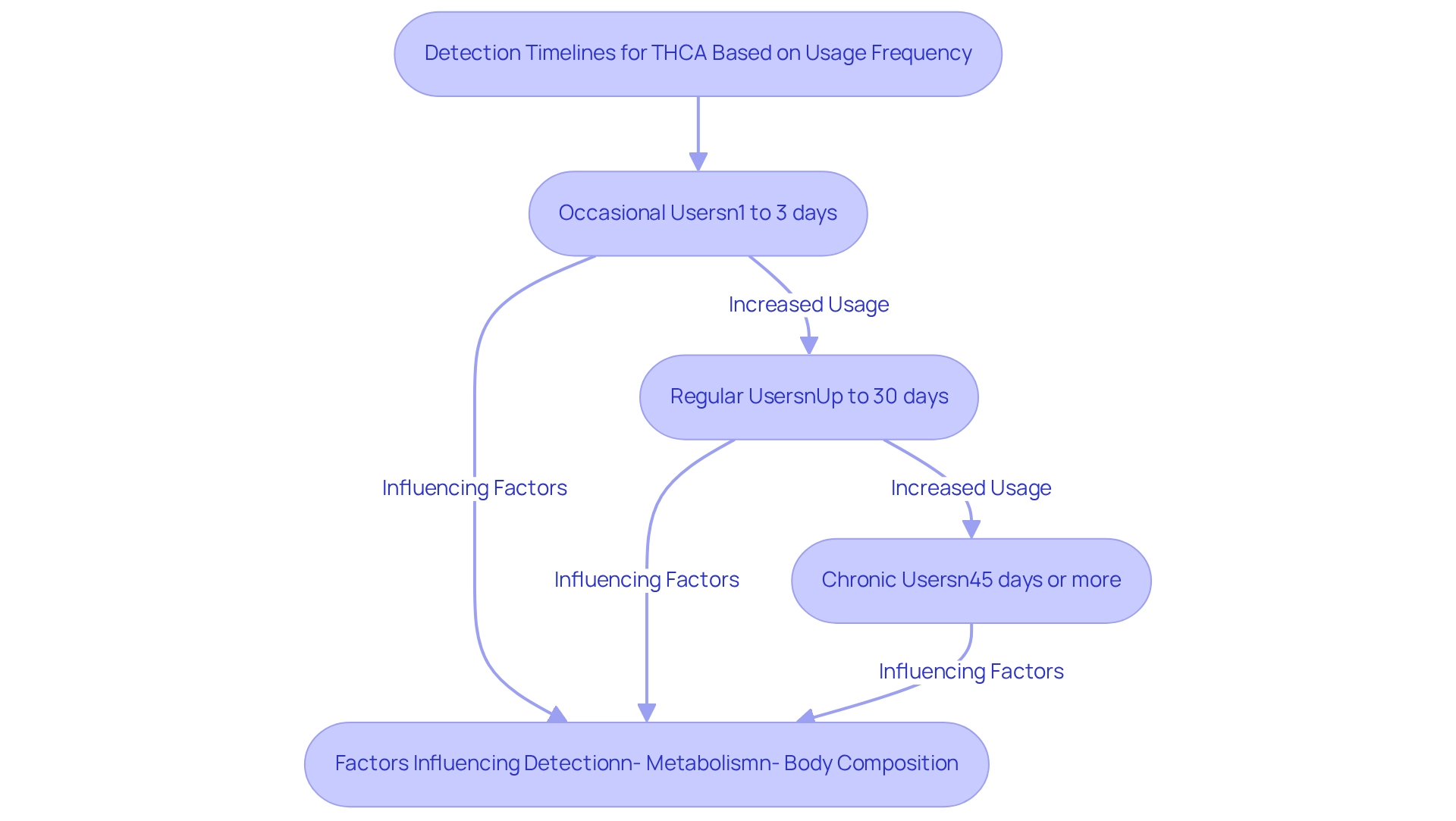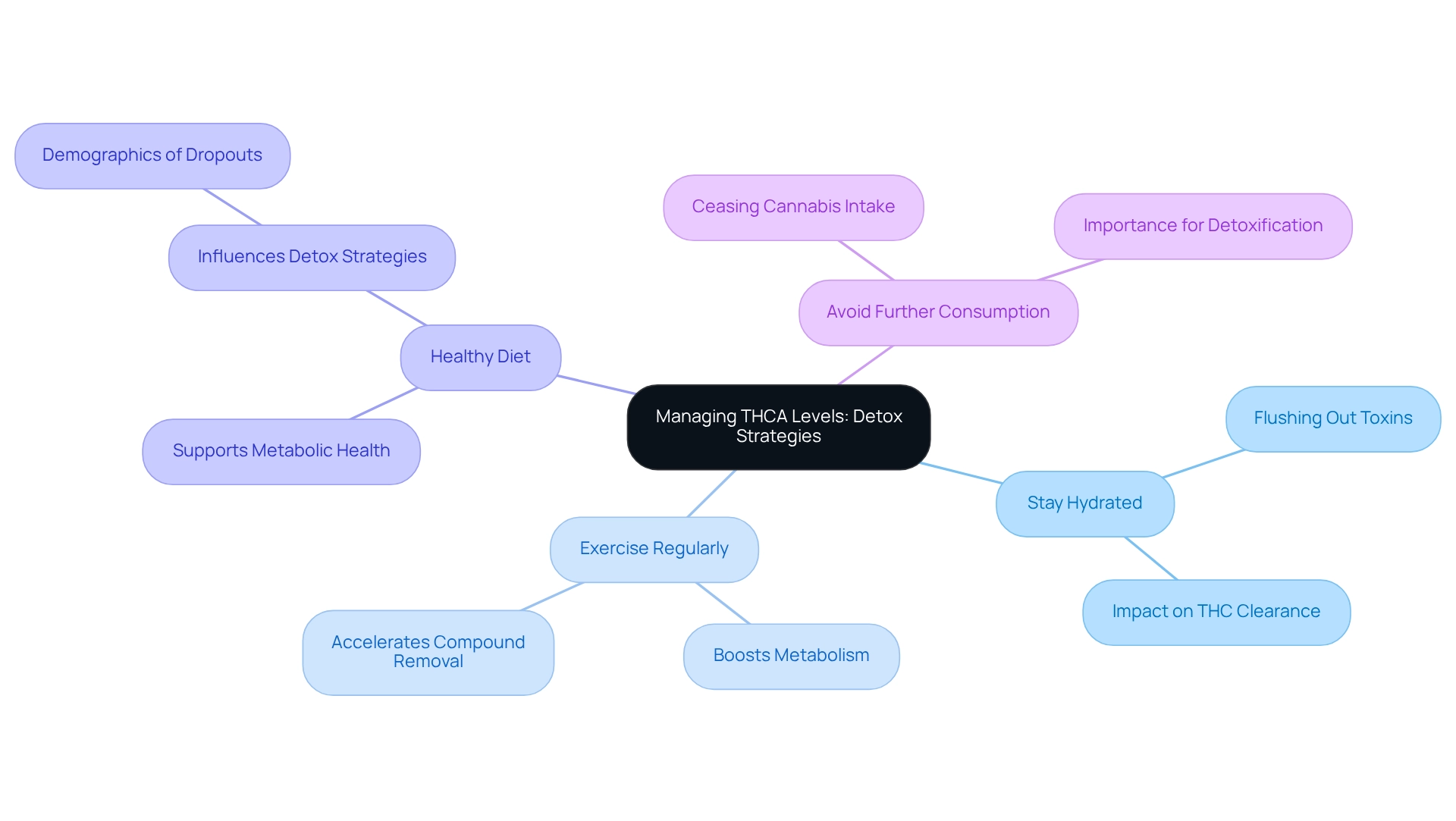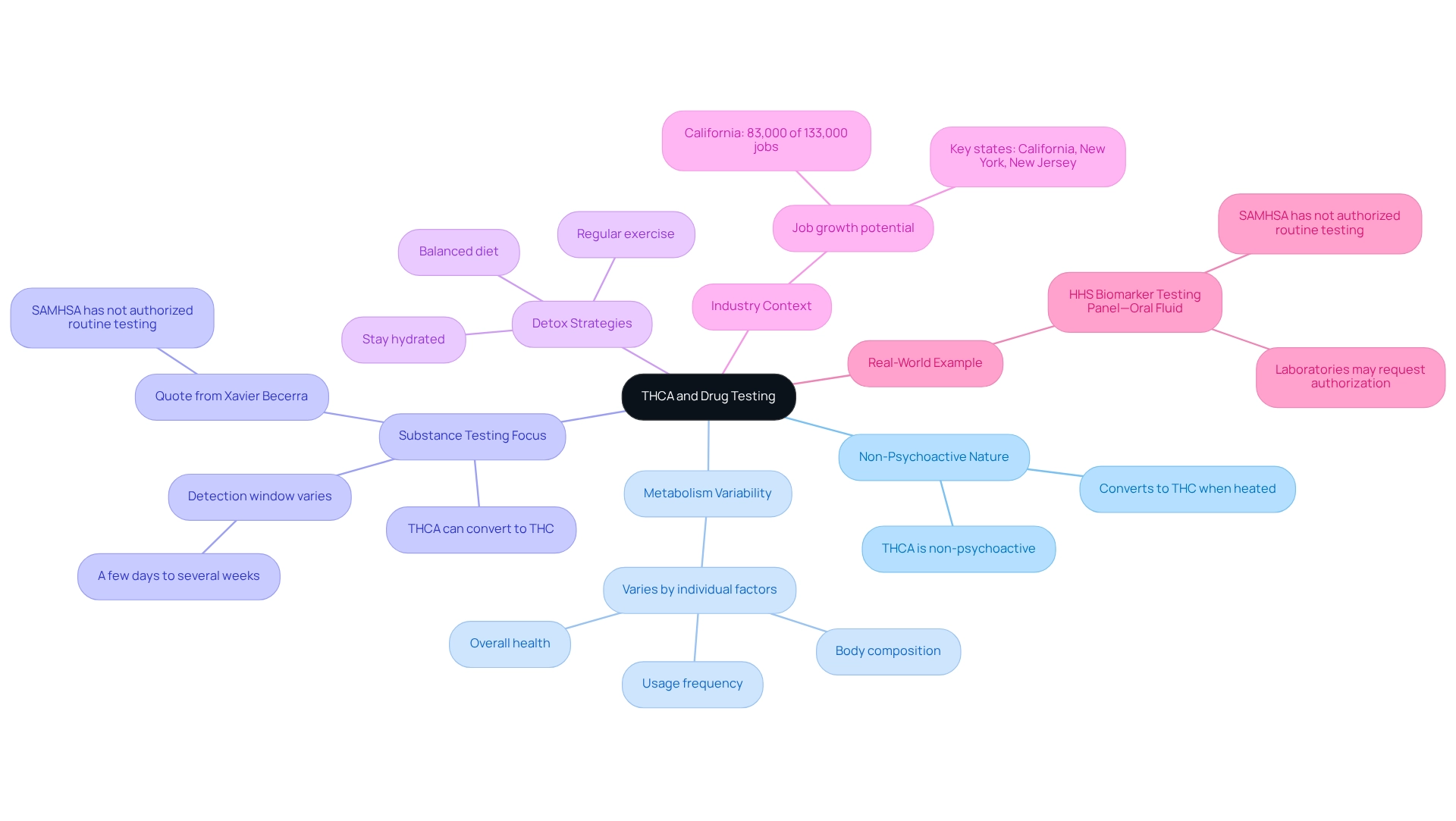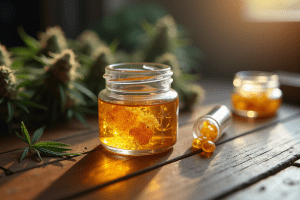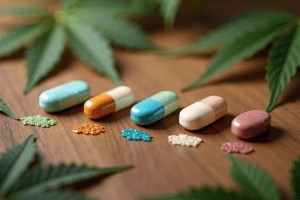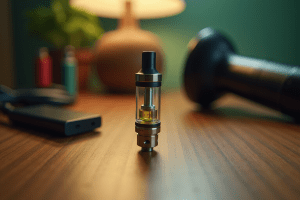Overview
Understanding how long THCA stays in your system is important, especially when considering your unique circumstances. Detection times can differ significantly based on factors like your metabolism, how often you use it, and the methods of consumption you choose.
For those who use THCA occasionally, it may be detectable for just 1 to 3 days. However, for regular or chronic users, it could linger in the system for up to 30 days or even longer.
This variation underscores the significance of individual metabolic rates. Have you thought about how your body might process THCA differently? It’s also crucial to note that during testing, THCA can convert to THC, which adds another layer of complexity to detection times. By being informed about these factors, you can make choices that align with your needs.
We encourage you to explore this topic further, as understanding it can empower you in your journey.
Introduction
In the evolving landscape of cannabis consumption, understanding cannabinoids like THCA (tetrahydrocannabinolic acid) is becoming increasingly vital. As a non-psychoactive precursor to THC, THCA presents a unique opportunity for those seeking the therapeutic benefits of cannabis without the intoxicating effects often associated with its more famous counterpart. With a growing body of research highlighting its potential health advantages—such as anti-inflammatory properties and support for mental health—many consumers are eager to explore how to incorporate THCA into their wellness routines.
However, navigating the complexities of metabolism, drug testing implications, and the nuances of various consumption methods can leave some feeling uncertain. Have you ever wondered how to responsibly integrate THCA into your life? This article delves into the essential aspects of THCA, offering insights into its benefits, metabolism, and the considerations you must keep in mind. Together, we can navigate the cannabis landscape with confidence and care.
What is THCA? Understanding the Basics
Tetrahydrocannabinolic acid, or THCA, is a non-psychoactive cannabinoid found in raw marijuana plants. As the precursor to THC (tetrahydrocannabinol), this compound does not produce the psychoactive effects typically associated with marijuana until it undergoes decarboxylation, a process activated by heat during smoking or cooking. This distinction is crucial for those seeking the therapeutic benefits of marijuana without the intoxicating effects of THC.
In its natural state, THCA is abundant in fresh marijuana plants and can be consumed through various methods, such as juices or edibles. This allows individuals to harness its potential health benefits, including anti-inflammatory properties, without experiencing a high. For example, adding fresh hemp leaves to a smoothie can provide the benefits of THCA while avoiding intoxication.
Research suggests that consuming non-psychoactive cannabinoids like THCA may positively impact health. A significant case study titled ‘Impact of Cannabis Treatment on Suicidal Ideation’ found that psychiatric patients prescribed marijuana experienced a reduction in suicidal thoughts and improved mood after three months of treatment. This indicates that cannabinoids can play a supportive role in mental health. President Volodymyr Zelenskiy has emphasized, “Legalization of marijuana is a tool that can be used to support mental health,” reinforcing the plant’s therapeutic potential.
Moreover, with Oklahoma having 36 dispensaries for every 100,000 residents, new consumers have greater access to marijuana products, facilitating the exploration of THCA’s potential advantages. Medical marijuana has been shown to reduce seizures in children with severe epilepsy by up to 50%, offering hope to families seeking effective treatment options. As interest in marijuana continues to grow, understanding the properties and benefits of THCA is essential for those looking to explore the plant’s potential while maintaining clarity and focus in their daily lives.
Navigating local dispensaries, such as those operated by Leafy Mate, can provide access to a variety of marijuana products, including topicals for localized relief. This ensures responsible use and informed choices. It’s important for new consumers to familiarize themselves with the types of dispensaries available—medical and recreational—and the legal requirements for purchasing cannabis products, which can vary by state. Together, we can explore these options and make choices that support our well-being.
Metabolism of THCA: How Your Body Processes It
When tetrahydrocannabinolic acid (THCA) is consumed, it enters the bloodstream and is primarily metabolized in the liver. This transformation into THC occurs through a process called decarboxylation, which involves removing a carboxyl group. It’s important to note that this conversion can happen not only when cannabis is heated but also through specific metabolic processes within our bodies.
Cannabinoids engage with specific receptors in the brain and throughout the body, influencing various physiological effects and connecting with multiple neurotransmitter systems. Have you ever wondered how these interactions might affect you personally?
The rate at which THCA is metabolized can vary significantly from person to person. Factors such as age, body composition, and overall health play a crucial role. For instance, individuals with a faster metabolic rate may process THCA more quickly than those with a slower metabolism. This leads many to question, how long does THCA stay in your system?
Research indicates that liver function is vital in this metabolic process. If liver function is impaired, it can slow the metabolism of tetrahydrocannabinolic acid, raising concerns about how long THCA remains in your system. Additionally, personal metabolic rates can be influenced by genetic factors, diet, and lifestyle choices, making it more challenging to evaluate the duration THC stays in the body.
Recent studies have shed light on the pharmacokinetics of THC, revealing that it has a long half-life and can be detected in various bodily fluids for extended periods, especially in chronic users. This highlights the significance of recognizing personal variations in cannabinoid metabolism, as they can greatly influence both the effects and duration of the substance in the body. Furthermore, Belen Palomares from the Instituto Maimonides de Investigacion Biomedica de Córdoba (IMIBIC) emphasizes, “Collectively, these observations qualify Δ-THCA-A, a compound devoid of psychotropic effects, as an efficacious pharmacological agent to manage metabolic syndrome and obesity-associated inflammation.”
This underscores the importance of this compound in managing health conditions, adding another layer to its significance in the cannabis landscape. Together, we can explore how understanding these processes can empower us to make informed choices about our health.
Does THCA Show Up on Drug Tests? Key Insights
Standard substance tests primarily aim to identify THC and its metabolites, rather than the acidic form of THC itself. It’s important to understand that while tetrahydrocannabinolic acid isn’t typically screened for in these tests, it can convert to THC when heated. This conversion is crucial because it suggests that using heated marijuana products, which transform compounds into THC, may lead to positive drug test results.
For instance, individuals using unheated cannabis products, like tinctures or edibles, are generally less likely to test positive for THC. In contrast, those who smoke or vaporize cannabis—methods that require heating the plant material—are more likely to test positive due to the transformation of the acid form of THC into its active form.
The detection windows for THC metabolites can vary significantly, lasting from days to weeks in urine. This variability raises questions about how long THCA stays in your system, depending on usage frequency. Understanding how different consumption methods can influence testing outcomes is vital. As CNS Occupational Medicine highlights, “Even if your product originated from a legal hemp source, your body will metabolize the THC into THC byproducts, resulting in a positive THC screening.”
Consequently, even if a product is legally obtained and contains THC acid, users should be aware that it can still lead to a positive THC test, especially in employment or legal contexts. Moreover, the case study titled “Legal Implications of THCA Consumption” emphasizes that regardless of THCA’s legal status, tests will still detect THC metabolites, potentially resulting in positive outcomes in employment or legal situations. This is further supported by research funded by the Intramural Research Program, National Institute on Substance Abuse, NIH, adding authority to the conversation around substance testing.
Types of Drug Tests: Sensitivity to THCA and THC
There are various types of substance tests commonly used to identify THC and its metabolites, each with unique features and detection capabilities that can impact your understanding of cannabis consumption.
Urine Tests: This is the most common method for THC detection, capable of identifying THC metabolites for several days to weeks after consumption. The detection window for THCA largely depends on how often someone uses cannabis. For chronic users, it’s possible to test positive for up to 30 days. However, it’s essential to recognize that urine tests do not indicate recent substance use, which raises concerns about how long THCA stays in your system—especially for those facing administrative offenses related to driving under the influence.
Blood Tests: These tests are primarily used for immediate detection, as THC can be present in the bloodstream for a few hours to a couple of days after use. This method is often employed in situations requiring quick results, like roadside testing. The accuracy of these tests is vital, as studies have shown discrepancies between initial screening results and confirmation analyses, highlighting the reliability of on-site tests.
Saliva Tests: Saliva tests are effective for detecting THC within a few hours of consumption, making them particularly popular for on-the-spot testing scenarios. Their quick turnaround time is beneficial for law enforcement and workplace testing, especially considering that the U.S. general workforce positivity rate is currently 4.6%, the highest level in two decades.
Hair Tests: Although less common due to their higher costs and longer detection windows, hair follicle tests can identify THC for up to 90 days. This method offers a longer-term perspective on substance use but is not typically used for immediate assessments.
It’s important to understand that each testing method has varying detection windows for THC and its metabolites, reflecting the complexities of cannabis consumption patterns.
For instance, while a urine test may reveal THC metabolites in chronic users for up to 30 days, a saliva test typically detects THC only for a few hours after use. This variability underscores the importance of understanding how long THCA stays in your system, especially in relation to the specific context and timing of substance testing. Furthermore, the impact of substance use on road traffic incidents is significant, with reports indicating an increase in substance-related car accidents. This highlights the necessity for efficient roadside testing. As nal von Minden noted, the deployment of trained police officers to identify DUID suspects by signs of recent use and recognizing impairment is crucial, further supporting the need for accurate drug testing methods. Together, we can navigate these complexities with informed choices and a commitment to safety.
How Long Does THCA Stay in Your System? Timelines Explained
Understanding how long cannabis remains identifiable in your system is essential, especially if you’re navigating cannabis consumption. Several factors can influence this duration, including how often you use it, your metabolism, and your body composition. Let’s explore the general detection timelines together:
- Occasional Users: If you use THCA infrequently, it may be detectable for about 1 to 3 days after a single use.
- Regular Users: For those who consume this compound more consistently, it might remain detectable for up to 30 days or even longer.
- Chronic Users: In cases of daily consumption, metabolites can linger in the body for 45 days or more, particularly in urine tests.
Detection times can vary significantly based on individual factors. For example, if you have a higher metabolic rate, you might break down cannabinoids more quickly, leading to shorter detection periods. Additionally, body fat plays a significant role; THC metabolites can be stored in fatty tissues and then released into the bloodstream, especially during physical activity, which may affect how long they can be detected.
Have you considered how exercise might influence the movement of THC metabolites? Engaging in physical activity can potentially affect the duration of THC’s detectability in your system.
Research shows that THC-COOH, a primary metabolite of THC, peaked at 179.4 ng/mL after just four hours, highlighting how quickly cannabinoids can be metabolized in some individuals. A case study titled “Chemistry, Metabolism, and Toxicology of Cannabis: Clinical Implications” underscores the importance of further research into the chronic effects of cannabis and its metabolites, especially as cannabis use becomes more common among youth. Understanding how long THCA stays in your system is crucial, particularly for those who may face substance testing.
For instance, if you’re a regular user, it may take several weeks for your body to completely eliminate the substance before a drug test. It’s also vital to remember that the raw variant does not produce the ‘high’ typically associated with marijuana use, which can influence how users perceive and approach consumption. This variability in detection times is something both occasional and chronic users should consider when planning their consumption. Together, let’s make informed choices about cannabis use and its implications.
THCA vs. THC: Understanding the Differences
Tetrahydrocannabinolic Acid and THC are two distinct cannabinoids, each with unique characteristics and effects on the human body.
- Tetrahydrocannabinolic Acid: This cannabinoid is non-psychoactive, meaning it does not induce the typical ‘high’ associated with marijuana use. Found in unprocessed marijuana, tetrahydrocannabinolic acid offers potential therapeutic benefits, including anti-inflammatory and neuroprotective properties, all without the intoxicating effects. Research indicates that this compound may help alleviate symptoms related to various medical conditions, such as chronic pain, chemotherapy-induced nausea, and multiple sclerosis. This makes it an appealing option for individuals seeking relief without the psychoactive experience. Additionally, medical marijuana has demonstrated the ability to reduce seizures in children with severe epilepsy by up to 50%, providing hope for families in need of effective treatment options.
- THC (Tetrahydrocannabinol): In contrast, THC is the psychoactive component of the plant, responsible for the euphoric sensations experienced by users. THC is formed when its acidic form undergoes decarboxylation, a process that occurs when the plant is heated, such as during smoking or cooking. This transformation is vital for those seeking the psychoactive effects of marijuana, as it activates the compound’s ability to bind to cannabinoid receptors in the brain. THC has also been found to relieve symptoms of multiple medical conditions, providing a comprehensive approach to healthcare.
Understanding the relationship between THC and its acid form is essential for consumers. For instance, consuming raw marijuana leaves allows individuals to benefit from THCA’s medicinal qualities without experiencing euphoria. Conversely, smoking or vaporizing marijuana converts the compound into THC, resulting in psychoactive effects that can vary based on personal tolerance and usage patterns.
Moreover, it is important for users to consider how long THCA remains in their system, as the detection of THC metabolites in the body varies depending on consumption methods and testing approaches. This distinction is particularly relevant for products derived from the plant available on the market today, as not all varieties are rich in THCA; early-stage plants contain higher amounts of THCA, which diminishes as the plant matures. Furthermore, it’s crucial to note that users must be 21 or older in Florida and New York to legally consume marijuana. By recognizing these differences, consumers can make informed choices about their products based on their desired effects and therapeutic needs.
As K. Verhoeckx noted in April 2017, understanding these nuances empowers consumers to choose the right products for their individual health and wellness goals. The legalization of medical cannabis not only offers hope to those who are suffering but also empowers individuals to take control of their healthcare, a principle that we at Leafy Mate wholeheartedly support.
Tips for Managing THCA Levels: Detox Strategies and Advice
If you’re worried about THCA levels in your system, we understand how important it is to find effective detox strategies. Here are some compassionate suggestions to consider:
- Stay Hydrated: Drinking plenty of water is essential, as it helps flush out toxins from your body. Research shows that proper hydration can significantly impact THC clearance, enhancing your body’s natural detoxification processes. As noted by JH, “We thank Emily Casey, Ginger Cloud, Miki Dash, Tonya Ferraro, Matthew MacKinnon, Sharon Mueller, Adam Rhodes-Rogan, and Beth Walsh for their help in the conduct of the study,” highlighting the collaborative efforts in understanding detoxification.
- Exercise Regularly: Engaging in physical activity not only boosts metabolism but also accelerates the removal of the compound. Regular exercise can lead to a more efficient detoxification process, prompting questions about how long THCA stays in your system. A study found that at a six-month follow-up, 8% of participants had not used marijuana in the last month, indicating varying patterns of usage and detoxification.
- Healthy Diet: A balanced diet rich in fruits and vegetables supports overall metabolic health and detoxification. Nutrient-rich foods can improve your body’s ability to process and remove compounds effectively. Interestingly, the demographics of six-month dropouts showed they were more likely to be male, younger, and non-minority users with an earlier age of onset of cannabis use, which may influence dietary choices and detox strategies.
- Avoid Further Consumption: Stopping the use of cannabis products is crucial to allow your body to clear existing levels. This step is vital for anyone wanting to understand how long THCA stays in your system effectively.
Hydration and exercise are key components of detoxification. For example, if you cease cannabis intake and include regular exercise, you may notice a significant decrease in detectable levels within a few weeks. Moreover, professionals suggest that combining hydration with physical activity can enhance the removal of this compound from your body, making these approaches especially beneficial for those looking to regulate their levels in 2025.
Additionally, insights from a case study on Multidimensional Family Therapy vs. Individual Psychotherapy reveal that effective treatment completion rates can be achieved, which may relate to managing marijuana use and detoxification. Understanding marijuana’s effects, which can include relaxation, euphoria, and heightened sensory perception, highlights the importance of these detox strategies. Together, we can navigate this journey towards better health.
Recap: Key Takeaways on THCA and Drug Testing
Understanding the compound is vital for cannabis consumers, particularly when considering how long THCA stays in your system and its effects on drug testing. Here are some important takeaways:
- Non-Psychoactive Nature: THCA (tetrahydrocannabinolic acid) is non-psychoactive in its raw form. It only converts to THC when exposed to heat, such as through smoking or cooking.
- Metabolism Variability: The metabolism of THCA can vary greatly among individuals due to factors like body composition, usage frequency, and overall health. It’s essential for users to recognize their unique responses.
- Substance Testing Focus: While standard tests primarily target THC, understanding how long THCA stays in your system is crucial, as it can convert to THC in the body. This conversion might lead to potential positive results on tests, even if only THCA-rich products were consumed. As noted by Xavier Becerra, Secretary of the Department of Health and Human Services, “SAMHSA has not yet authorized routine testing for any biomarker in oral fluid,” which highlights the evolving landscape of drug testing.
The detection window for THCA can vary widely, raising the question of how long it stays in your system, with ranges from a few days to several weeks depending on individual usage patterns and amounts consumed. Frequent users may find themselves wondering how long THCA remains identifiable, as this compound can persist for extended periods. For instance, a study showed that the average norfentanyl concentration increased significantly with different doses, illustrating the complexities of substance testing. - Detox Strategies: To manage THCA levels effectively, users can adopt several detox strategies. Staying hydrated, engaging in regular exercise, and maintaining a balanced diet can all help speed up the elimination of cannabinoids from the body. Additionally, the Department is reviewing and approving biomarkers for Federal workplace drug testing, which may influence future detox strategies.
- Industry Context: The marijuana sector is rapidly evolving, with significant job growth potential in key states like California, New York, and New Jersey. Currently, California has only 83,000 of a potential 133,000 jobs, indicating a growing market that marijuana users should be aware of.
- Real-World Example: The HHS Biomarker Testing Panel—Oral Fluid case study illustrates the current state of substance testing and its implications for marijuana users. Similar to urine testing, SAMHSA has not yet authorized routine testing for biomarkers in oral fluid, but laboratories may request authorization for testing Federal agency specimens.
By considering these points, cannabis users can make informed decisions about their consumption and better manage their THCA levels. Together, we can promote responsible use and awareness of the implications for drug testing.
Conclusion
Understanding THCA is essential for anyone navigating the complexities of cannabis consumption. This non-psychoactive cannabinoid, found in raw cannabis, offers a range of therapeutic benefits without the intoxicating effects associated with THC. As research continues to unveil its potential—from anti-inflammatory properties to support for mental health—consumers are encouraged to explore safe methods of incorporating THCA into their wellness routines.
However, it’s crucial to recognize how THCA is metabolized in the body, particularly regarding drug testing. The conversion of THCA to THC upon heating means that we must be mindful of our consumption methods to avoid unexpected positive drug test results. Individual factors such as metabolism, body composition, and frequency of use can significantly influence how long THCA remains detectable in our bodies.
In addition to understanding the nuances of THCA, implementing detox strategies such as:
- hydration
- regular exercise
- a balanced diet
can further support us in managing our cannabinoid levels. As the cannabis landscape evolves, staying informed about the implications of THCA and THC, along with the legal and health considerations surrounding their use, empowers us to make educated choices that align with our health goals. Ultimately, embracing this knowledge fosters a responsible approach to cannabis consumption, ensuring that we can benefit from its therapeutic properties while navigating the complexities of modern cannabis use.
Frequently Asked Questions
What is tetrahydrocannabinolic acid (THCA)?
THCA is a non-psychoactive cannabinoid found in raw marijuana plants. It is the precursor to THC and does not produce psychoactive effects until it undergoes decarboxylation, which occurs when heated during smoking or cooking.
How can THCA be consumed?
THCA can be consumed through various methods, such as juices or edibles. For example, adding fresh hemp leaves to a smoothie allows individuals to benefit from THCA without experiencing intoxication.
What health benefits are associated with THCA?
THCA may have potential health benefits, including anti-inflammatory properties. Research suggests that non-psychoactive cannabinoids like THCA can positively impact health, such as reducing suicidal thoughts and improving mood in psychiatric patients.
How does THCA affect mental health?
A significant case study indicated that psychiatric patients prescribed marijuana experienced a reduction in suicidal thoughts and improved mood after three months of treatment, suggesting that cannabinoids can play a supportive role in mental health.
What role does access to marijuana products play in exploring THCA?
Increased access to marijuana products, such as in Oklahoma where there are many dispensaries, facilitates the exploration of THCA’s potential advantages for new consumers.
How is THCA metabolized in the body?
When consumed, THCA enters the bloodstream and is primarily metabolized in the liver, where it transforms into THC through a process called decarboxylation.
What factors influence the metabolism of THCA?
The metabolism of THCA can vary significantly among individuals, influenced by factors such as age, body composition, overall health, genetic factors, diet, and lifestyle choices.
How long does THCA stay in the system?
The duration THCA remains in the system can vary based on personal metabolic rates and liver function. Impaired liver function can slow metabolism, while chronic users may detect THC in bodily fluids for extended periods.
What significance does THCA have in managing health conditions?
THCA is recognized as an efficacious pharmacological agent for managing metabolic syndrome and obesity-associated inflammation, highlighting its importance in the cannabis landscape.
Get Your Medical Card
Connect with a licensed physician online in minutes


